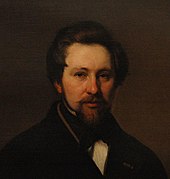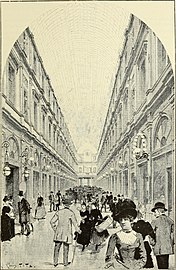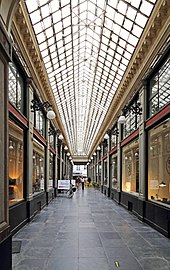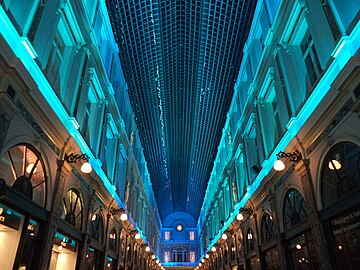Royal Saint-Hubert Galleries
 | |
 | |
| Location | City of Brussels,Brussels-Capital Region, Belgium |
|---|---|
| Coordinates | 50°50′51″N4°21′18″E/ 50.84750°N 4.35500°E |
| Address | Rue du Marché aux Herbes/Grasmarkt90 |
| Opening date | 20 June 1847 |
| Architect | Jean-Pierre Cluysenaar |
| Public transit access | Brussels-Central |
| Website | Official website |
TheRoyal Saint-Hubert Galleries(French:Galeries Royales Saint-Hubert;Dutch:Koninklijke Sint-Hubertusgalerijen) is an ensemble of three glazed shoppingarcadesin centralBrussels,Belgium. It consists of theKing's Gallery(French:Galerie du Roi;Dutch:Koningsgalerij), theQueen's Gallery(French:Galerie de la Reine;Dutch:Koninginnegalerij) and thePrinces' Gallery(French:Galerie des Princes;Dutch:Prinsengalerij).
The galleries were designed and built by the architectJean-Pierre Cluysenaarbetween 1846 and 1847,[1][2]and precede other famous 19th-century European shopping arcades, such as theGalleria Vittorio Emanuele IIinMilanand thePassageinSaint Petersburg.[3]Like them, they have twin regular facades with distant origins inVasari's long narrow street-like courtyard of theUffiziinFlorence,with glazed arched shopfronts separated bypilastersand two upper floors, all in anItalianateCinquecentostyle, under an arched glass-paned roof with a delicatecast-ironframework. The complex was designated ahistoric monumentin 1986.[4]
The galleries are located in the block between theRue du Marché aux Herbes/Grasmarktand theRue de la Montagne/Bergstraatto the south and east, theRue d'Arenberg/Arenbergstraatand theRue de l'Ecuyer/Schildknaapsstraatto the north, and theRue des Dominicains/Predikherenstraatand theRue des Bouchers/Beenhouwersstraatto the west.[3]This site is served byBrussels-Central railway station.
History
[edit]The Royal Saint-Hubert Galleries were designed by the young architectJean-Pierre Cluysenaar,who determined to sweep away a warren of ill-lit alleyways between theRue du Marché aux Herbes/Grasmarktand theRue Montagne aux Herbes Potagères/Warmoesbergand replace a sordid space where thebourgeoisiescarcely ventured into with a covered shopping arcade more than 200 m (660 ft) in length.[5]His idea, conceived in 1836, was finally authorised in February 1845. The partnershipSociété des Galeries Saint-Hubert,in which the banker Jean-André Demot took an interest, was established by the summer of that year, but nine years were required to disentangle all the property rights, assembled by rights of eminent domain, during a process that caused one property owner to die of a stroke, and abarber,it was said, to slit his throat as the adjacent house came down.[6]

Construction started on 6 May 1846, lasting for thirteen months, and the 213-metre-long (699 ft) passage was inaugurated on 20 June 1847 byKing Leopold Iand his two sons.[7][1][2]In 1845, theSociéténamed the three sections of the new passage theGalerie du Roi/Koningsgalerij( "King's Gallery" ), theGalerie de la Reine/Koninginnegalerij( "Queen's Gallery" ) and theGalerie des Princes/Prinsengalerij( "Princes' Gallery" ).[8]The ensemble, called thePassage Saint-Hubert( "Saint-Hubert Passage" ) has borne its present name since 1965.
Under its mottoOmnibus omnia( "Everything for everybody" ), displayed in thefrontonof its palace-like facade,[3]the Saint-Hubert Galleries were an immediate success and became the favourite meeting and strolling place for Brussels' residents and tourists. Brilliantly lit, they offered the luxury of outdoorcafésin Brussels' inclement climate, in an ambiance of luxury retailers that brought to the city the true feel of a European capital.[9]In the premises ofLa Chroniquedaily newspaper, on 1 March 1896, the first public showing ofmoving picturestook place of thecinematographers Lumière,fresh from their initial triumph inParis.[10][2]
A theatre inside the King's Gallery, theRoyal Theatre of the Galleries,was designed by Cluysenaar and opened 7 June 1847. It became one of three royal theatres of Brussels, alongside theRoyal Theatre of La Monnaieand theRoyal Park Theatre,playingoperettaand revues. Its interior was rebuilt in 1950–51 by the architectPaul Bonduelle.[11]Another theatre, the Théâtre du Vaudeville, located in the former premises of the Casino des Galeries Saint-Hubert inside the Queen's Gallery, was inaugurated in 1884.[12]Still inside the Queen's Gallery, a cinema, the Cinéma des Galeries, was built in 1939 by Bonduelle.[10]
The Royal Galleries were designated ahistoric monumenton 19 November 1986.[4]In 2008, they were submitted forWorld Heritageinscription and are included inUNESCO's "Tentative List" in the cultural heritage category.[9]Nowadays, the King's Gallery is home to the Museum of Letters and Manuscripts, which honours the greatest men and women of art, history, music, the humanities and science.[2]
-
The Royal Saint-Hubert Galleries (King's Gallery pictured) in the late 19th century
-
View of the south entrance to the galleries in 1884, illustration fromBruxelles à travers les âges
-
Interior view of the galleries in 1884
Description
[edit]The Royal Galleries consist of two major sections, each more than 100 metres (330 feet) in length (respectively called theGalerie du Roi/Koningsgalerij,meaning "King's Gallery", and theGalerie de la Reine/Koninginnegalerij,meaning "Queen's Gallery" ), and a smaller side gallery (theGalerie des Princes/Prinsengalerij,meaning "Princes' Gallery" ). The main sections (King's and Queen's Gallery) are separated by aperistyleat the point where theRue des Bouchers/Beenhouwersstraatcrosses the gallery complex. At this point, there is a discontinuity in the straight perspective of the galleries. This "bend" was introduced purposefully in order to make the long perspective of the galleries, with its repetition of arches, pilasters and windows, less tedious.[13]
- The King's Gallery (French:Galerie du Roi,Dutch:Koningsgalerij) stretches from the Rue des Bouchers to theRue d'Arenberg/Arenbergstraatand theRue de l'Ecuyer/Schildknaapsstraat.[3]It notably houses theRoyal Theatre of the Galleries.[14]
- The Queen's Gallery (French:Galerie de la Reine,Dutch:Koninginnegalerij), to the south, leads to theRue du Marché aux Herbes/Grasmarkt,near theGrand-Place/Grote Markt(Brussels' main square),[3]and on the other side of this street begins the Horta Gallery. Its best known shops are Delvaux leather goods andNeuhauschocolatier.It also houses the Taverne du Passage restaurant.[10]
- The Princes' Gallery (French:Galerie des Princes,Dutch:Prinsengalerij) is located perpendicularly between the King's Gallery and theRue des Dominicains/Predikherenstraat.[3]It is home to Tropismes bookshop.[11]
-
The south entrance on theRue du Marché aux Herbes/Grasmarkt
-
Overview of the King's Gallery
-
The small side of the Princes' Gallery
-
Light show organised for the 170th anniversary of the galleries in 2017
See also
[edit]- Arcade galleries in Brussels
- History of Brussels
- Culture of Belgium
- Belgium in the long nineteenth century
References
[edit]Citations
[edit]- ^ab"History of the Galeries Royales Saint-Hubert in Brussels: a marvelous story".Royal Gallery of Saint Hubert.Retrieved27 October2018.
- ^abcd"Galeries Royales Saint-Hubert".visit.brussels.Retrieved27 October2018.
- ^abcdefMardaga 1994,p. 301.
- ^abRégion de Bruxelles-Capitale (2016)."Galeries Royales Saint-Hubert"(in French). Brussels.Retrieved4 July2022.
- ^Willaumez 1994,p. 14.
- ^Willaumez 1994,p. 18–19.
- ^Willaumez 1994,p. 21.
- ^Willaumez 1994,p. 23.
- ^abCentre, UNESCO World Heritage."Les passages de Bruxelles / Les Galeries Royales Saint-Hubert - UNESCO World Heritage Centre".whc.unesco.org.Retrieved27 October2018.
- ^abcMardaga 1994,p. 305.
- ^abMardaga 1994,p. 306.
- ^Mardaga 1994,p. 304–305.
- ^Willaumez 1994,p. 26.
- ^Mardaga 1994,p. 301–302.
Bibliography
[edit]- Grosjean, Paul (2022).Galerie Royales (Saint-Hubert), Star des galeries, Galeries des stars(in French). Brussels: Édition Ventures.
- Willaumez, Marie-France (1983).Les passages-galeries du XIXe siècle à Bruxelles(in French). Brussels: Ministère de la Communauté française.
- Willaumez, Marie-France (1994).Trois visages de passages au XIXe siècle.Bruxelles, ville d'Art et d'Histoire (in French). Vol. 7. Brussels: Éditions de la Région de Bruxelles-Capitale.
- Le Patrimoine monumental de la Belgique: Bruxelles(PDF)(in French). Vol. 1C: Pentagone N-Z. Liège: Pierre Mardaga. 1994.
External links
[edit] Media related toRoyal Saint-Hubert Galleriesat Wikimedia Commons
Media related toRoyal Saint-Hubert Galleriesat Wikimedia Commons- Galeries' official website
- Galeries Royales Saint-HubertAn account filled with detail.
- Galeries Royales Saint-HubertDiscovery guide with high quality pictures of the Royal Saint-Hubert Galleries.
- Panoramic photography virtual tour of the Royal Saint-Hubert Galleries







